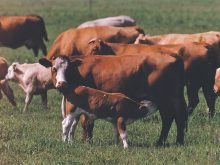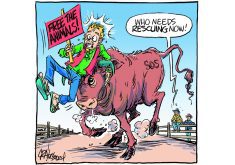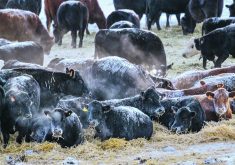When a calf is born with a defect, the producer needs to ask if it was inherited. Unfortunately, the answer may not be clear.
Consider goiter. This condition can be caused by a genetic defect, but it can also be induced by iodine deficiency. Producers can sometimes make an educated guess about inherited anomalies, but to do so, they need to understand the basics of genetics.
Each cell of the body, except red blood cells, contains thousands of paired genes. They code for metabolic functions at the cellular level, but also for obvious and important things such as whether to develop into a pig, person or peacock. Fathers and sons look similar because genes, passed through generations, determine the shapes of noses, the alignment of teeth, the colour of eyes and thousands of other traits.
Read Also

Canola or cars? Canada can’t save both
Canola is a winning industry. It feeds the economy, supports thousands of families and helps keep our rural communities alive.
Genes are often referred to as either dominant or recessive, which reflects how genes express themselves, but not whether they are superior or inferior.
The dominant-recessive model of paired genes is best demonstrated by the inheritance of coat colour. A black gene is dominant over red, so a black animal has either two black genes or one black and one red. A red animal always has two red genes.
If a black bull carrying one recessive red gene and one dominant black gene is mated to an identical black cow, they will each pass either one red or one black gene to their offspring. This means there is a 25 percent chance a calf will inherit two red genes – one from each parent. In the Black Angus breed, one calf in about 400 is born red because there are a few individuals in the population that carry a red recessive gene.
For genetic buffs, there is also a 75 percent chance that the offspring of this mating will be black. Two out of every four calves born to these parents will have one black and one red gene and one of the four calves will carry two black genes.
The polled-horned condition is another example of dominant-recessive gene expression. In this case, polled genes are dominant over horned. If polled parents produce a horned calf, both parents must be carrying a recessive horned gene.
Recessive genes are important because they cause most of the heritable anomalies recognized in cattle. A single recessive gene is always hidden, so it is not possible to recognize a carrier. The dominant, or normal, gene keeps the animal healthy. When two carriers are mated, that can produce a calf with the recessive defect, just as a red calf can be born to two black parents.
How can you tell if an undesirable trait is inherited or caused by the environment? If a defect is seen only during one season in many animals, or if it is seen only in cattle grazing a certain pasture, it could be caused by something in the environment, such as plant toxicity or an infectious disease.
If a condition suddenly appears in a herd after a new sire is introduced, an inherited condition should be suspected.
Purebred animals are perpetuated from a limited number of breed foundation members so they are genetically similar, which makes them more prone to genetic disease than crossbreds. The likelihood of matings between carriers of undesirable recessive traits is higher when breeding purebreds.
There is no doubt 21st century technology will help producers identify heritable diseases in their breeding stock. Blood tests already exist that detect the presence of a few recessive genes that would otherwise be hidden. Eventually, this will become an important tool for identifying carriers of economically significant genetic diseases.
For now, producers need to scrutinize the parents of calves with genetic defects. Do their positive attributes outweigh the fact that they carry an unwanted recessive gene? Should they be culled or kept in a breeding program?














